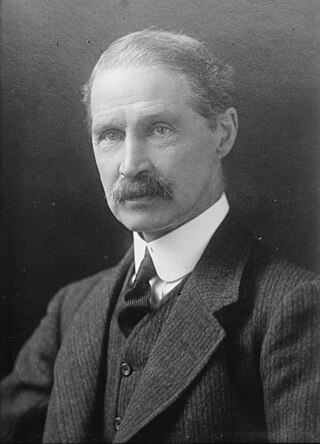Top Qs
Timeline
Chat
Perspective
Conservative government, 1922–1924
Government of the United Kingdom From Wikipedia, the free encyclopedia
Remove ads
The Conservative Government of the United Kingdom that began in 1922 and ended in 1924 consisted of two ministries: the Law ministry (from 1922 to 1923) and then the first Baldwin ministry (from 1923 onwards).
Baldwin led the Government through 1924. He resigned after losing the confidence of the House of Commons.
The government was led by Bonar Law and Stanley Baldwin, appointed respectively as Prime Minister by King George V.
Remove ads
Cabinets
Law's cabinet, October 1922 – May 1923
- Bonar Law – Prime Minister and Leader of the House of Commons
- George Cave, 1st Viscount Cave – Lord High Chancellor of Great Britain
- James Edward Hubert Gascoyne-Cecil, 4th Marquess of Salisbury – Lord President of the Council and Chancellor of the Duchy of Lancaster
- Stanley Baldwin – Chancellor of the Exchequer
- William Clive Bridgeman – Secretary of State for the Home Department
- George Curzon, 1st Marquess Curzon of Kedleston – Secretary of State for Foreign Affairs and Leader of the House of Lords
- Victor Cavendish, 9th Duke of Devonshire – Secretary of State for the Colonies
- Edward George Villiers Stanley, 17th Earl of Derby – Secretary of State for War
- William Peel, 1st Earl Peel – Secretary of State for India
- Ronald Munro Ferguson, 1st Viscount Novar – Secretary for Scotland
- Leo Amery – First Lord of the Admiralty
- Sir Philip Lloyd-Greame – President of the Board of Trade
- Sir Robert Sanders – Minister of Agriculture and Fisheries
- Edward Wood – President of the Board of Education
- Sir Anderson Barlow – Minister of Labour
- Sir Arthur Griffith-Boscawen – Minister of Health
Changes
- April 1923 – Griffith-Boscawen resigned as Minister of Health after losing his seat and was succeeded by Neville Chamberlain.
Baldwin's cabinet, May 1923 – January 1924
- Stanley Baldwin – Prime Minister, Chancellor of the Exchequer and Leader of the House of Commons
- George Cave, 1st Viscount Cave – Lord High Chancellor of Great Britain
- James Gascoyne-Cecil, 4th Marquess of Salisbury – Lord President of the Council
- Robert Cecil, 1st Viscount Cecil of Chelwood – Lord Keeper of the Privy Seal (Viscount Cecil of Chelwood from 28 December 1923[1])
- William Clive Bridgeman – Secretary of State for the Home Department
- George Nathaniel Curzon, 1st Marquess Curzon of Kedleston – Secretary of State for Foreign Affairs and Leader of the House of Lords
- Victor Cavendish, 9th Duke of Devonshire – Secretary of State for the Colonies
- Edward George Villiers Stanley, 17th Earl of Derby – Secretary of State for War
- William Peel, 1st Earl Peel – Secretary of State for India
- Sir Samuel Hoare – Secretary of State for Air
- Ronald Munro Ferguson, 1st Viscount Novar – Secretary for Scotland
- Leo Amery – First Lord of the Admiralty
- Sir Philip Lloyd-Greame – President of the Board of Trade
- Sir Robert Sanders – Minister of Agriculture
- Edward Wood – President of the Board of Education
- Sir Anderson Barlow – Minister of Labour
- Neville Chamberlain – Minister of Health
- Sir William Joynson-Hicks – Financial Secretary to the Treasury
- Sir Laming Worthington-Evans, 1st Baronet – Postmaster-General
Changes
- August 1923 – Neville Chamberlain took over from Baldwin as Chancellor of the Exchequer. Sir William Joynson-Hicks succeeded Chamberlain as Minister of Health. Joynson-Hicks' successor as Financial Secretary to the Treasury was not in the Cabinet.
Remove ads
List of ministers
Summarize
Perspective
Members of the Cabinet are shown in bold face.
- Notes
Remove ads
See also
References
Wikiwand - on
Seamless Wikipedia browsing. On steroids.
Remove ads




